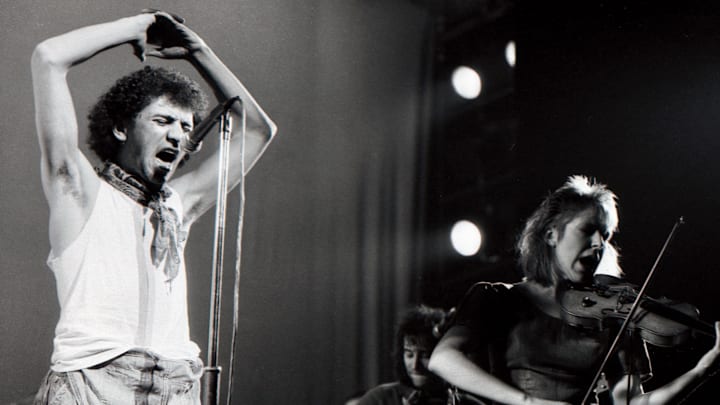1982
Spring Session M by Missing Persons
Missing Persons never got the attention they deserved. Their blend of creative rock instrumentation and quirky vocals was almost immediately overshadowed by the likes of Madonna and Cyndi Lauper. Their debut album scored a few minor hits in “Words” and “Destination Unknown” but they never really took off after that.
It’s too bad because Dale Bozzio was a vocalist of great character and the other members of the band – especially drummer Terry Bozzio (Dale's husband at the time) and guitarist Warren Cuccurullo – were tight as they come. Most of the band had played with Frank Zappa before branching out on their own, and their thirst for fine-tuned experimentation is obvious from the opening track, “Noticeable One.” “Walking in L.A.” is pitch-perfect new wave, but they could go harder on tracks like "Rock and Roll Suspension” and “Here and Now.”
Missing Persons would put out three albums in their first run, then would reform a few times over the years to release new material and covers. The 2023 album Hollywood Lie features a lower range for Bozzio but nonetheless maintains a great new-wave vibe.
Shoot out the Lights by Richard and Linda Thompson
It is one of the great break-up albums of all time. Richard had been with the seminal British folk outfit Fairport Convention before setting off on his own. Linda sang with him on some early solo work, then married him in time to put out the marvelous I Want to See Bright Lights Tonight in 1974. By 1982, the marriage was ending, as attested to in the title of their final album together. But they laid it all out.
Richard’s outstanding songwriting and virtuoso guitar work pairs perfectly with Linda’s pristine vocals. The desperation of Richard’s opening plea, “Don’t Renege on Our Love,” is an ideal entry point. Then Linda’s gorgeous “Walking on a Wire” offers the other side of the story. What Linsday Buckingham and Stevie Nicks managed on the opening two tracks of Rumors is essentially played out over an entire album here.
There’s the monumental title track and utterly tragic “Did She Jump or Was She Pushed,” which features some of Linda’s most haunting vocals. It all concludes with the glorious carnival ride of “Wall of Death,” a duet that takes a clear-eyed look at the magic and the perils of embarking on a romance.
Bad Brains by Bad Brains
Bad Brains’ debut vaults relentlessly forward on the technical brilliance of guitarist Gary Miller (AKA Dr. Know). The non-stop locomotive rhythm provided by bassist Darryl Jenifer and drummer Earl Hudson allows Dr. Know to riff wherever he wants.
And then there is Earl's older brother, Paul Hudson, better known as H.R. He was one of the most fascinating voices in hardcore punk – both in the way he was able to deliver a vocal and in the message he was delivering. Bad Brains was famous for their explosive live shows, and though it was never really captured in the studio, the self-titled album comes pretty darned close. The speed and raw energy of the opening five tracks climax with “Banned in D.C.” (Yes, this is another band from my hometown. D.C. was crucial to the punk scene in the 1970s and 1980s.)
Immediately after that searing track, they turn to H.R.’s other main influence, with a slow, reggae groove on “Jah Calling.” They mix in a few other off-tempo reggae numbers to vary the pace, but Bad Brains are at their revolutionary best when they are blasting the paint off the walls with hypersonic speed punk like “Pay to Cum.” The Beastie Boys’ Adam Yauch described Bad Brains as the greatest punk album ever released.
Rip It Up by Orange Juice
The title track from the Scottish post-punk band Orange Juice, with its unforgettable bass riff, became the band’s best-known song. It plays with that wiry, ska-tinged groove that the Buzzcocks had perfected quite nicely. But it was on the second track, “A Million Pleading Faces,” that the band’s true genius showed up. The track was written and performed by drummer Zeke Manyika.
Manyika was born in what is now Zimbabwe, and though he lived the majority of his life in the UK, he brought a very different vibe to Orange’s Juice’s sound. Edward Collins, who wrote and sang the majority of Orange Juice’s songs, brought his own sense of jangly drama, as on “Mud in Your Eye.”
Guitarist Malcolm Ross added a totally different voice that had echoes of Scottish folk music along with totally new and progressive rock & roll with his compositions. It was in the creative clashing of these various perspectives, most clearly heard on “Hokoyo,” that Orange Juice created a sound that would influence punk and world music in the decades to come. Collins and Manyika would only put out one album after Rip It Up, but their influence continues to this day.
